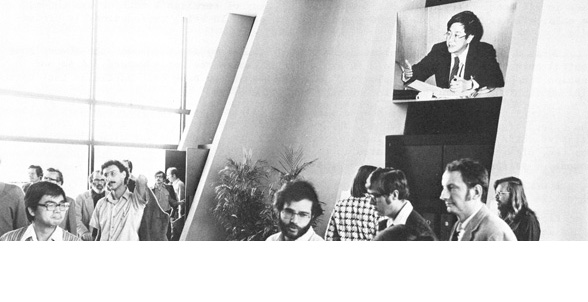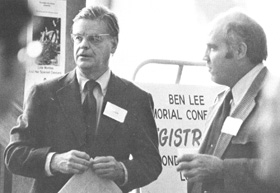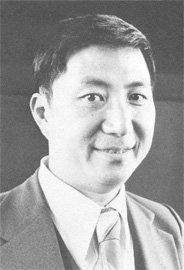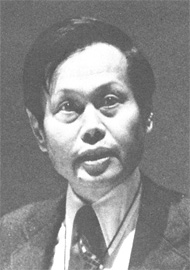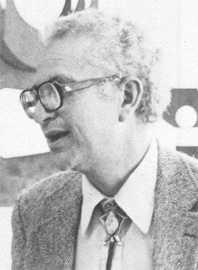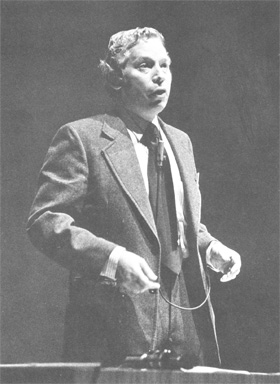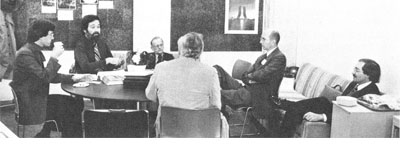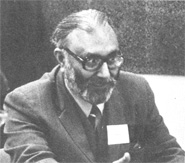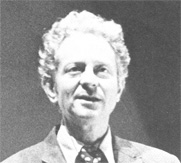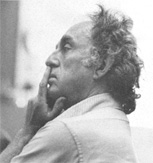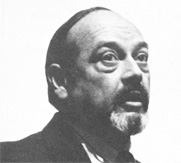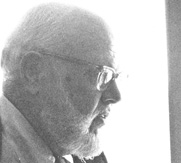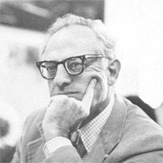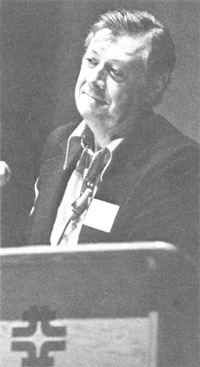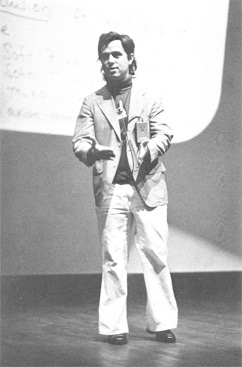Physicists/Cosmologists Compare Notes at Fermilab Conference
We gave a conference last week . . . and over 600 scientists from around the world came.
Ultimate questions about the nature of matter were debated. The "Ben Lee Memorial International Conference on Parity Nonconservation, Weak Neutral Currents and Gauge Theories" honored the late Fermilab Theory Department Head killed in a June auto accident. The three-day meeting brought together physicists and cosmologists--researchers attempting to unravel the infinitesimal of the atom and the infinite of the universe.
About 550 persons registered, with another 100 occasional observers estimated. Canadian representatives (23) led foreign visitors from 16 countries. They included: Australia, Canada, France, East Germany, Italy, Japan, Korea, Mexico, the Netherlands, Nigeria, Sweden, Switzerland, West Germany, United Kingdom, U.S.S.R., and Yugoslavia.
Closer to home, 29 states were represented. Illinois residents (150) out-numbered all others, with 60 New Yorkers heading out-of-state participants. Some 59 Fermilab staff/users attended.
Held Thursday through Saturday, the conference attracted three Nobel physics laureates. They were: Murray Gell-Mann, California Institute of Technology; Samuel C.C. Ting, Massachusetts Institute of Technology; and Chen Ning Yang, State University of New York-Stony Brook.
Conference chairman was David Cline, Laboratory colliding beam studies experimenter and a University of Wisconsin physics professor. "Outstanding physicists from several disciplines were assembled for a short, intense conference," he said.
"It was called to discuss the present status of experimental data in particle physics, nuclear physics, atomic physics and astrophysics. The conference also honored the discovery of parity nonconservation--left and right 'handedness' in all molecules--20 years ago."
"Weak neutral currents, discovered four years ago at CERN and Fermilab, appear to form a significant link in evidence for unified theories of the weak and electromagnetic interaction. For this reason, there was a strong focus on experiments that relate to the weak interaction," he said.
Dr. Cline summarized the conference by saying, "There were debates; advocates and opposition. Evidence presented seemed to indicate that the gauge principle is almost certainly a fundamental theory of nature."
The conference also revealed, Dr. Cline said, remarkable progress apparently being made in all areas of experimental physics, "The power of Fermilab's machine was shown," he said. "It is joining the world's great laboratories in being extraordinarily productive."
He said two important sessions focused on particle physics. In one, the theory that neutral currents could play a role in explosion of supernovae was advanced. A second session touched on a "flavor explosion," discoveries of new subatomic particles that have yielded results apparently consistent with gauge theories.
"A real commemoration" was 'how he termed the tributes paid the late Benjamin W. Lee, who helped organize the conference. Speakers offered anecdotes, statements or other creative words in memoriam. During the opening day, Dr. C. N. (Frank) Yang, a close associate of Dr. Lee, offered a eulogy (reprinted in this Village Crier). The audience stood for a moment of silence at the conclusion of the service.
A special section in the conference proceedings, to be published next year, will chronicle conference testimonials to Dr. Lee.
Professor Martin Perl of the Stanford Linear Accelerator reported on his discovery of a new lepton, a subatomic particle dubbed "Tau." At a news conference, he said that there may be many more leptons than the five identified, and that more will be discovered.
Summarizing the conference, Steven Weinberg of Harvard told reporters, "We're now trying to develop fundamental theories and, at the same time, sort out a lot of things that we're finding in experiments.
"The pattern will not be like the periodic table (of elements); it will emerge, but not in an orderly way. A certain point has been passed," he said, "because of the successes, and there are dozens of phenomena that have been seen."
Nobel Laureate Dr. Samuel Ting termed the conference "exceptional" in an interview with reporters. He said work being done at Fermilab in discovering new particles is impressive. His personal studies, underway at CERN, are concentrating on the search for new quarks. Dr. Ting shared the 1976 Nobel Prize for discovery of the Psi/J particle, called the most exciting link in a chain of discoveries confirming the "new physics."
John Wheeler, formerly of Princeton University and now of the University of Texas, spoke on the "cosmic connection" between subatomic particles and the infinite universe. Recently he has been concentrating on reconciling two central ideas of 20th century physics: the quantum theory and general relativity.



